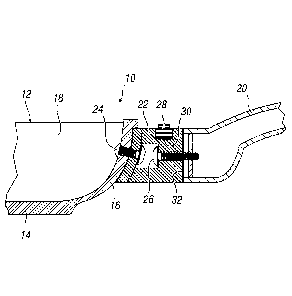Une partie des informations de ce site Web a été fournie par des sources externes. Le gouvernement du Canada n'assume aucune responsabilité concernant la précision, l'actualité ou la fiabilité des informations fournies par les sources externes. Les utilisateurs qui désirent employer cette information devraient consulter directement la source des informations. Le contenu fourni par les sources externes n'est pas assujetti aux exigences sur les langues officielles, la protection des renseignements personnels et l'accessibilité.
L'apparition de différences dans le texte et l'image des Revendications et de l'Abrégé dépend du moment auquel le document est publié. Les textes des Revendications et de l'Abrégé sont affichés :
| (12) Demande de brevet: | (11) CA 3126994 |
|---|---|
| (54) Titre français: | RECIPIENT POUR CUIRE DES ALIMENTS COMPRENANT UN DISPOSITIF DE SIGNALEMENT THERMIQUE |
| (54) Titre anglais: | VESSEL FOR COOKING FOOD PROVIDED WITH A THERMAL SIGNALING DEVICE |
| Statut: | Examen |
| (51) Classification internationale des brevets (CIB): |
|
|---|---|
| (72) Inventeurs : |
|
| (73) Titulaires : |
|
| (71) Demandeurs : |
|
| (74) Agent: | ROBIC AGENCE PI S.E.C./ROBIC IP AGENCY LP |
| (74) Co-agent: | |
| (45) Délivré: | |
| (22) Date de dépôt: | 2021-08-06 |
| (41) Mise à la disponibilité du public: | 2022-03-01 |
| Requête d'examen: | 2024-04-17 |
| Licence disponible: | S.O. |
| Cédé au domaine public: | S.O. |
| (25) Langue des documents déposés: | Anglais |
| Traité de coopération en matière de brevets (PCT): | Non |
|---|
| (30) Données de priorité de la demande: | ||||||
|---|---|---|---|---|---|---|
|
A vessel (10) for cooking food is described, comprising a body (12)
which in turn comprises a bottom wall (14) and at least one side wall (16).
The side wall (16) extends from the bottom wall (14) to define an inner space
(18) of the vessel (10) where food is placed in order for it to be cooked. The
vessel (10) for cooking food also comprises at least one handle (20), made
from a first metal material, preferably steel, and bound to a portion of the
body (12) through the interposition of at least one connection element (22)
made from a second metal material, preferably aluminum. The coefficient of
thermal conductivity of the second metal material, which the connection
element (22) is made from, is greater than the coefficient of thermal
conductivity of the first metal material, which the handle (20) is made from.
The connection element (22) is operationally connected to at least one
thermal signaling device (28).
Note : Les revendications sont présentées dans la langue officielle dans laquelle elles ont été soumises.
Note : Les descriptions sont présentées dans la langue officielle dans laquelle elles ont été soumises.

2024-08-01 : Dans le cadre de la transition vers les Brevets de nouvelle génération (BNG), la base de données sur les brevets canadiens (BDBC) contient désormais un Historique d'événement plus détaillé, qui reproduit le Journal des événements de notre nouvelle solution interne.
Veuillez noter que les événements débutant par « Inactive : » se réfèrent à des événements qui ne sont plus utilisés dans notre nouvelle solution interne.
Pour une meilleure compréhension de l'état de la demande ou brevet qui figure sur cette page, la rubrique Mise en garde , et les descriptions de Brevet , Historique d'événement , Taxes périodiques et Historique des paiements devraient être consultées.
| Description | Date |
|---|---|
| Paiement d'une taxe pour le maintien en état jugé conforme | 2024-08-02 |
| Requête visant le maintien en état reçue | 2024-08-02 |
| Lettre envoyée | 2024-04-18 |
| Requête d'examen reçue | 2024-04-17 |
| Modification reçue - modification volontaire | 2024-04-17 |
| Toutes les exigences pour l'examen - jugée conforme | 2024-04-17 |
| Modification reçue - modification volontaire | 2024-04-17 |
| Exigences pour une requête d'examen - jugée conforme | 2024-04-17 |
| Demande publiée (accessible au public) | 2022-03-01 |
| Inactive : Page couverture publiée | 2022-02-28 |
| Représentant commun nommé | 2021-11-13 |
| Lettre envoyée | 2021-11-10 |
| Exigences relatives à une correction du demandeur - jugée conforme | 2021-11-10 |
| Exigences de dépôt - jugé conforme | 2021-11-10 |
| Inactive : Correction au certificat de dépôt | 2021-09-14 |
| Inactive : CIB attribuée | 2021-09-03 |
| Inactive : CIB attribuée | 2021-09-03 |
| Inactive : CIB en 1re position | 2021-09-03 |
| Exigences applicables à la revendication de priorité - jugée conforme | 2021-08-31 |
| Lettre envoyée | 2021-08-31 |
| Demande de priorité reçue | 2021-08-31 |
| Exigences de dépôt - jugé conforme | 2021-08-31 |
| Inactive : CQ images - Numérisation | 2021-08-06 |
| Représentant commun nommé | 2021-08-06 |
| Demande reçue - nationale ordinaire | 2021-08-06 |
| Inactive : Pré-classement | 2021-08-06 |
Il n'y a pas d'historique d'abandonnement
Le dernier paiement a été reçu le 2024-08-02
Avis : Si le paiement en totalité n'a pas été reçu au plus tard à la date indiquée, une taxe supplémentaire peut être imposée, soit une des taxes suivantes :
Veuillez vous référer à la page web des taxes sur les brevets de l'OPIC pour voir tous les montants actuels des taxes.
| Type de taxes | Anniversaire | Échéance | Date payée |
|---|---|---|---|
| Taxe pour le dépôt - générale | 2021-08-06 | 2021-08-06 | |
| TM (demande, 2e anniv.) - générale | 02 | 2023-08-08 | 2023-07-28 |
| Requête d'examen - générale | 2025-08-06 | 2024-04-17 | |
| TM (demande, 3e anniv.) - générale | 03 | 2024-08-06 | 2024-08-02 |
Les titulaires actuels et antérieures au dossier sont affichés en ordre alphabétique.
| Titulaires actuels au dossier |
|---|
| ZWILLING BALLARINI ITALIA S.R.L. |
| Titulaires antérieures au dossier |
|---|
| FRANCESCO FERRON |